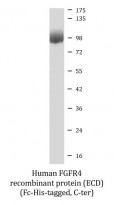ARG70256
Human FGFR4 recombinant protein (Active) (ECD) (Fc-His-tagged, C-ter)
Human FGFR4 recombinant protein (Active) (ECD) (Fc-His-tagged, C-ter) for Binding Activity,Functional study,SDS-PAGE and Human
Overview
| Product Description | HEK293 expressed, Fc-His-tagged (C-ter) Active Human FGFR4 recombinant protein (ECD). |
|---|---|
| Tested Reactivity | Hu |
| Tested Application | Binding, FuncSt, SDS-PAGE |
| Target Name | FGFR4 (ECD) |
| Species | Human |
| A.A. Sequence | Leu22 - Asp369 of Human FGFR4 (NP_998812.1) with an Fc-6X His tag at the C-terminus. |
| Expression System | HEK293 |
| Activity | Active |
| Activity Note | Measured by its ability to inhibit FGF-acidic dependent proliferation of Balb/c 3T3 mouse fibroblasts. The ED50 for this effect is typically 0.03-0.12 ng/ml. |
| Alternate Names | TKF; FGFR-4; CD antigen CD334; JTK2; CD334; EC 2.7.10.1; Fibroblast growth factor receptor 4 |
Application Instructions
| Application Note | Binding activity test: Measured by its binding ability in a functional ELISA. Immobilized recombinant human FGF2 at 1 ug/ml (100 µl/well) can bind recombinant human FGFR4 with a linear range of 30-125 ng/ml. Binding activity test: Measured by its binding ability in a functional ELISA. Immobilized recombinant human FGFR4 at 5ug/ml (100 µl/well) can bind recombinant human FGF12 with a linear range of 35-100ng/ml. |
|---|
Properties
| Form | Powder |
|---|---|
| Purification Note | 0.22 µm filter sterilized. Endotoxin level is <0.1 EU/µg of the protein, as determined by the LAL test. |
| Purity | >95% (by SDS-PAGE) |
| Buffer | PBS (pH 7.4) |
| Reconstitution | Reconstitute to a concentration of 0.1 - 0.5 mg/ml in sterile distilled water. |
| Storage Instruction | For long term, lyophilized protein should be stored at -20°C or -80°C. After reconstitution, aliquot and store at -20°C for up to one month, at 2-8°C for up to one week. Storage in frost free freezers is not recommended. Avoid repeated freeze/thaw cycles. Suggest spin the vial prior to opening. |
| Note | For laboratory research only, not for drug, diagnostic or other use. |
Bioinformation
| Gene Symbol | FGFR4 |
|---|---|
| Gene Full Name | fibroblast growth factor receptor 4 |
| Background | The protein encoded by this gene is a tyrosine kinase and cell surface receptor for fibroblast growth factors. The encoded protein is involved in the regulation of several pathways, including cell proliferation, cell differentiation, cell migration, lipid metabolism, bile acid biosynthesis, vitamin D metabolism, glucose uptake, and phosphate homeostasis. This protein consists of an extracellular region, composed of three immunoglobulin-like domains, a single hydrophobic membrane-spanning segment, and a cytoplasmic tyrosine kinase domain. The extracellular portion interacts with fibroblast growth factors, setting in motion a cascade of downstream signals, ultimately influencing mitogenesis and differentiation. [provided by RefSeq, Aug 2017] |
| Function | Tyrosine-protein kinase that acts as cell-surface receptor for fibroblast growth factors and plays a role in the regulation of cell proliferation, differentiation and migration, and in regulation of lipid metabolism, bile acid biosynthesis, glucose uptake, vitamin D metabolism and phosphate homeostasis. Required for normal down-regulation of the expression of CYP7A1, the rate-limiting enzyme in bile acid synthesis, in response to FGF19. Phosphorylates PLCG1 and FRS2. Ligand binding leads to the activation of several signaling cascades. Activation of PLCG1 leads to the production of the cellular signaling molecules diacylglycerol and inositol 1,4,5-trisphosphate. Phosphorylation of FRS2 triggers recruitment of GRB2, GAB1, PIK3R1 and SOS1, and mediates activation of RAS, MAPK1/ERK2, MAPK3/ERK1 and the MAP kinase signaling pathway, as well as of the AKT1 signaling pathway. Promotes SRC-dependent phosphorylation of the matrix protease MMP14 and its lysosomal degradation. FGFR4 signaling is down-regulated by receptor internalization and degradation; MMP14 promotes internalization and degradation of FGFR4. Mutations that lead to constitutive kinase activation or impair normal FGFR4 inactivation lead to aberrant signaling. [UniProt] |
| Cellular Localization | Cell membrane; Single-pass type I membrane protein. Endosome. Endoplasmic reticulum. Note=Internalized from the cell membrane to recycling endosomes, and from there back to the cell membrane. Isoform 2: Secreted. Isoform 3: Cytoplasm. [UniProt] |
| Calculated MW | 88 kDa |
| PTM | N-glycosylated. Full maturation of the glycan chains in the Golgi is essential for high affinity interaction with FGF19. Ubiquitinated. Subject to proteasomal degradation when not fully glycosylated. Autophosphorylated. Binding of FGF family members together with heparan sulfate proteoglycan or heparin promotes receptor dimerization and autophosphorylation on tyrosine residues. Autophosphorylation occurs in trans between the two FGFR molecules present in the dimer. [UniProt] |
Images (1) Click the Picture to Zoom In






